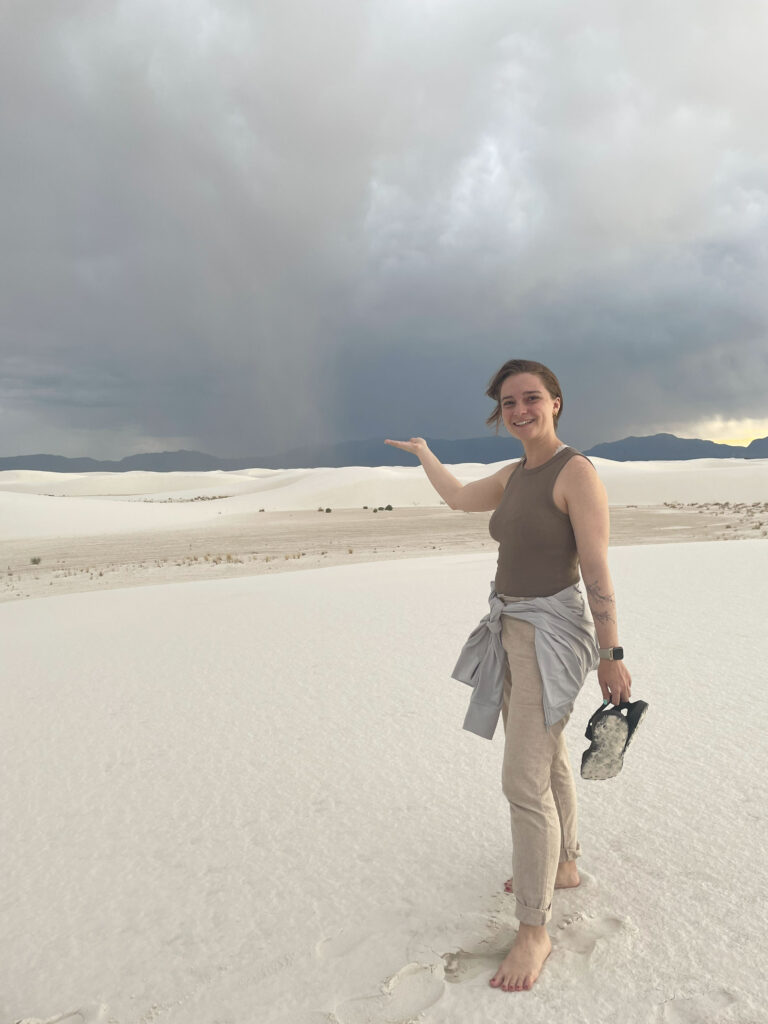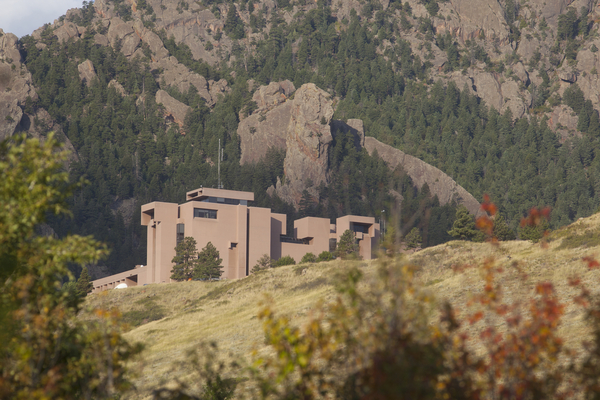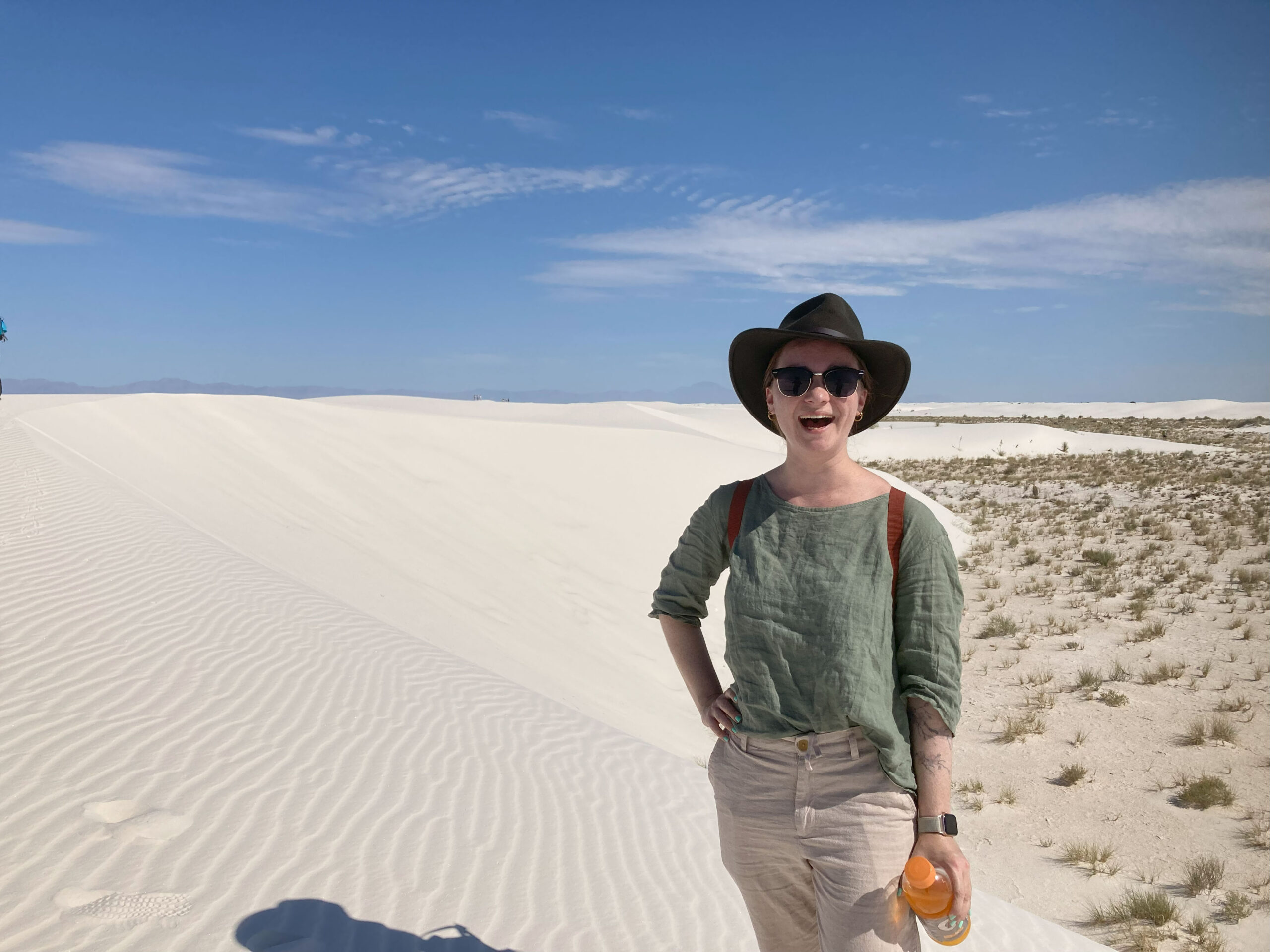Over the last two years, Emily Faber, Ph.D. candidate in atmospheric physics, painstakingly replicated part of a NASA climate model on UMBC computing systems. She compared the model’s predictions to on-the-ground data collected at meteorological stations run by the National Oceanic and Atmospheric Administration (NOAA)—and she found significant differences between the two.
Specifically, the NASA model predicted wind speeds in some places above the Arabian Peninsula that differed from the observed measurements by two meters per second, even when Faber looked at the average over 20 years. Wind speed in that region, which is mostly desert, influences the presence of dust in the atmosphere, which, in turn, plays a role in everything from the greenhouse effect to nourishing the Amazon rainforest.
“I was really surprised at the magnitude of the differences,” Faber says. “It’s a model miss. We’re not modeling wind speed as well as we could.”
That’s why she created the replicate model—so she could tinker with the parameters, refining the model so it more accurately reflects reality. A publication on her results is under review, and the findings have significant implications for global climate modeling and forecasting. This will also be Faber’s first, first-author paper, which is an important milestone for any graduate student.
Model mentors
Faber’s latest modeling work would not have been possible without the Weather Program Office Innovation for Next Generation Scientists (WINGS) Dissertation Fellowship, sponsored by NOAA. Faber was one of only three fellows selected for the program’s inaugural year. The fellowship, which began in summer 2023, supplies two years of full funding for her dissertation research and provides Faber with a dedicated NOAA mentor. Her mentor, Barry Baker, Ph.D. ’14, atmospheric physics, has always been supportive and responsive to Faber’s probing questions, she says—“which is great, because I have many.”
“Emily is extremely motivated and shows the characteristics for a long and successful career within the science community. I’m excited to be working with her and help guide her through this stage of her education,” Baker says. “Emily’s work through the WINGS Fellowship will end up having direct impacts on the operational forecasts using the Unified Forecast System that NOAA provides to give advance warning of extreme particulate matter pollution caused by wind-driven processes.”

Adriana Rocha Lima, Ph.D. ’15, atmospheric physics, and an assistant professor of physics at UMBC, serves as Faber’s Ph.D. advisor. Faber says she appreciates Rocha Lima’s consistent encouragement and has had many opportunities to mature as a researcher under her mentorship. Faber was full of creative, ambitious research ideas when she approached Rocha Lima about joining her lab—but didn’t yet have a clear understanding of how to implement them, Faber says. “But she didn’t run away from that,” Faber says of Rocha Lima. Instead, Rocha Lima welcomed Faber into the lab and quickly got her started on both modeling and observations-based projects.
Rocha Lima is the rare physicist who has expertise in both modeling and experimental work. “There’s not a challenge I think she couldn’t handle,” Faber says.
Getting up to speed
As Rocha Lima’s first graduate student, Faber found herself in a unique position to help the lab grow from the ground up. That included opportunities to write grants and apply for fellowships, including WINGS, very early in her graduate school career.
With all that practice, “Now I know how to do it,” Faber says. “I know how to get funding and how to write a scientific statement to fit three years of work into two pages or less.”
“It’s actually helpful to have someone advising me who doesn’t have English as a first language, because if I write something and she doesn’t get it the first time, it’s not clearly communicated,” Faber adds. Rocha Lima is originally from Brazil and is a native speaker of Portuguese.
Faber has also enhanced her scientific acumen since she joined Rocha Lima’s lab in 2021. “In the beginning, she was learning how to run the model, repeating prior analyses,” Rocha Lima says. “Now she’s exploring new territory. That’s the contribution that we want to see from a Ph.D. student.”
Faber feels the shift, too. “The real building that I’ve gone through in this program is to be able to talk to other scientists who are in it and be up to speed,” she says. “I’m just now in the last year or so getting to that point where you can fire off questions and add your own ideas.”
The value of connections
As part of the WINGS fellowship, Faber traveled to the National Center for Atmospheric Research (NCAR) in Boulder, Colorado for a workshop on the United Forecast System (UFS), a huge integrated set of analysis systems that look at everything from ice to dust to vegetation in order to model the Earth as a comprehensive system.
At the workshop, Faber met some of the key people working with various systems she is interested in at NOAA. And months later, at the national American Meteorological Society conference, she saw many of them again. “Out of several thousand humans, I was like, ‘I know you, I know you, I know you…’ and I wouldn’t have known them without going out to Boulder,” Faber says.

The two other WINGS fellows also attended the workshop, and the three of them have stayed in touch since. “It feels like a tiny cohort,” she says. “We do very different things, but we overlap at some point. We’re all working in the UFS system.” Faber is looking forward to meeting the incoming class of WINGS fellows, too.
Everyone wins
The WINGS program is a major stepping stone for Faber toward her long-term goal of working at one of the national laboratories, a network of research institutions across the country associated with various federal agencies.
In particular, “I really vibe with the NOAA mission,” Faber says, and the WINGS program has “turned out to be a really great interface between the national labs and the university.”
The fellowship furthers Faber’s personal career trajectory, and it also supports Rocha Lima’s growing lab by providing funding for Faber’s Ph.D. As a result, Rocha Lima has been able to add an additional graduate student to her group. NOAA and NCAR also benefit from the energy, talent, and fresh ideas coming from the fellows. Although it is new, Faber and her mentors are looking forward to it continuing to support students and the pursuit of atmospheric research.
As Faber says, “It’s a win-win.”
Tags: Alumni, CNMS, GradResearch, Impact, Physics, Research, Spring 2024

